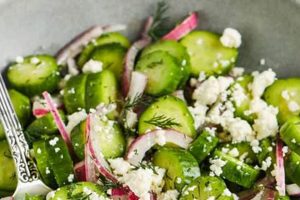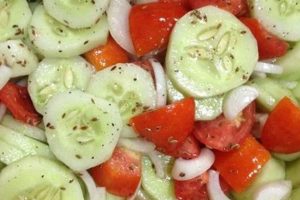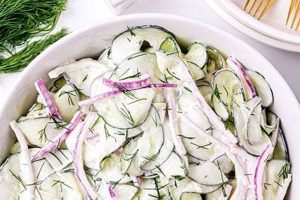A tangy, acidic element is essential for balancing the flavors in a cucumber and onion salad. This acidity brightens the fresh, sometimes mild, flavors of the vegetables and adds a depth that elevates the dish beyond a simple combination of ingredients. Common acidic components include various types of vinegar, such as white vinegar, apple cider vinegar, or rice vinegar, but lemon or lime juice can also be used. The chosen acid contributes not only to the overall taste but also to the texture of the salad by subtly pickling the cucumbers and onions.
The use of an acidic component in this type of salad has practical and culinary benefits. Historically, vinegar served as a preservative, extending the life of fresh produce. While refrigeration has largely negated this need, the acidic element now primarily contributes to flavor enhancement and textural improvement. The slight pickling effect creates a pleasant crispness in the vegetables while balancing their inherent sweetness and adding a refreshing tartness.
This exploration of acidic components in cucumber and onion salads will delve further into specific vinegar varieties, their individual flavor profiles, and how they complement the other ingredients. The discussion will also cover the appropriate proportions and techniques for incorporating the acidic element to achieve the desired balance and texture.
Tips for Using Vinegar in Cucumber and Onion Salad
Achieving the perfect balance of flavors and textures in a cucumber and onion salad relies heavily on the judicious use of vinegar. The following tips offer guidance on selecting and incorporating this crucial ingredient.
Tip 1: Vinegar Selection: Different vinegars offer unique flavor profiles. White vinegar provides a sharp, clean acidity, while apple cider vinegar lends a subtle sweetness. Rice vinegar contributes a mild, slightly sweet tang. Consider the overall flavor profile desired when selecting a vinegar.
Tip 2: Concentration: Most recipes call for diluted vinegar. A common ratio is one part vinegar to two parts water. Adjusting this ratio allows for customization of the acidity level.
Tip 3: Maceration Time: Allowing the cucumbers and onions to macerate in the vinegar mixture for at least 15 minutes, and up to an hour, enhances the flavor and creates a desirable texture. Over-maceration, however, can result in an overly soft, mushy salad.
Tip 4: Balancing Sweetness: A touch of sugar or a sweetener like honey or maple syrup can balance the acidity of the vinegar and enhance the overall flavor profile. Start with a small amount and adjust to taste.
Tip 5: Adding Herbs and Spices: Fresh dill, mint, or parsley can complement the flavors of the salad and the vinegar. A pinch of black pepper or red pepper flakes can add a subtle layer of complexity.
Tip 6: Salt Enhances Flavor: Salt not only seasons the salad but also draws out excess moisture from the cucumbers and onions, contributing to a crisper texture and intensifying the flavors.
Tip 7: Timing is Key: Add the vinegar dressing just before serving to prevent the vegetables from becoming soggy. This ensures optimal texture and flavor.
By understanding the role of vinegar and employing these tips, one can consistently create a refreshing and flavorful cucumber and onion salad.
These insights provide a solid foundation for crafting a delightful cucumber and onion salad. Experimentation with different vinegars, herbs, and spices allows for personalized variations.
1. Type
Vinegar type is a critical factor influencing the overall flavor profile of a cucumber and onion salad. Selecting the appropriate vinegar requires consideration of its inherent characteristics and how they interact with the other ingredients. The following facets explore the impact of various vinegar types on this classic salad.
- White Vinegar
Known for its sharp, pungent acidity, white vinegar delivers a clean, bracing flavor. Its neutral profile allows other ingredients, such as herbs and spices, to shine. While effective for pickling and providing a crisp, refreshing element, white vinegar can be overpowering if used in excess within a cucumber and onion salad. Careful dilution is essential to achieve a balanced taste.
- Apple Cider Vinegar
Offering a milder acidity than white vinegar, apple cider vinegar possesses a subtle sweetness derived from the apples used in its production. This sweetness complements the flavors of cucumbers and onions, creating a more rounded and complex flavor profile. Apple cider vinegar also contributes a slightly fruity aroma that enhances the overall sensory experience. It pairs well with sweeter onion varieties like Vidalia or red onion.
- Rice Vinegar
Characterized by its delicate, slightly sweet flavor and low acidity, rice vinegar contributes a subtle tang without overpowering the other ingredients. Its mildness makes it a versatile choice, particularly suited for salads incorporating Asian-inspired flavors like sesame oil or ginger. Different varieties of rice vinegar exist, including seasoned rice vinegar, which already contains added sugar and salt, requiring adjustments to other seasoning components.
- Red Wine Vinegar
Red wine vinegar offers a robust, complex flavor profile derived from red wine. It carries notes of fruit and oak, adding depth and complexity to the salad. Its relatively high acidity provides a sharp counterpoint to the sweetness of the onions and cucumbers. Red wine vinegar pairs well with bolder herbs like oregano or thyme, contributing to a more savory salad experience.
The selection of vinegar type provides a foundation upon which the overall flavor profile of the cucumber and onion salad is built. Careful consideration of each vinegar’s unique attributes, from acidity levels to complementary flavors, allows for a tailored and balanced culinary experience. Choosing the right vinegar elevates the simple combination of cucumbers and onions into a nuanced and flavorful dish.
2. Acidity
Acidity plays a crucial role in cucumber and onion salads, impacting both flavor and preservation. The vinegar component introduces this acidity, balancing the sweetness of the vegetables and contributing to the overall sensory experience. Understanding the nuances of acidity is essential for crafting a well-balanced and flavorful salad.
- pH Level
The pH level, a measure of acidity or alkalinity, directly influences the salad’s taste and texture. Lower pH values indicate higher acidity. Vinegar, with its low pH, not only provides the characteristic tartness but also acts as a mild preservative, inhibiting bacterial growth and extending the salad’s shelf life. Different vinegars possess varying pH levels, influencing the final product’s overall acidity.
- Flavor Enhancement
Acidity brightens the flavors of the cucumbers and onions. The tartness of the vinegar cuts through the vegetables’ natural sweetness, creating a more complex and balanced flavor profile. This interplay of contrasting tastes enhances the palatability of the salad. The specific type of vinegar chosen, such as white vinegar or apple cider vinegar, further contributes to the overall flavor profile due to its unique characteristics.
- Texture Modification
The acidic environment created by the vinegar affects the texture of the vegetables. The process, similar to pickling, firms the cucumbers and onions, adding a desirable crispness. The extent of this textural change depends on the vinegar’s acidity and the duration of the vegetables’ exposure to the acidic marinade. Proper management of acidity ensures a pleasant textural experience.
- Balancing Sweetness
Acidity counteracts excessive sweetness, particularly relevant when using sweeter onion varieties or adding sweeteners to the salad. The tartness of the vinegar provides a counterpoint to the sweetness, preventing the salad from becoming cloying. This balance of sweet and sour is a hallmark of well-executed cucumber and onion salads.
Careful consideration of acidity is paramount in achieving a well-balanced cucumber and onion salad. The interaction of the vinegar’s pH, its influence on flavor and texture, and its role in balancing sweetness contribute significantly to the final product’s quality. Understanding these facets of acidity empowers one to create a truly delightful culinary experience.
3. Quantity
The quantity of vinegar used in a cucumber and onion salad directly impacts the final dish’s balance, flavor profile, and textural qualities. Careful consideration of vinegar quantity is essential for achieving the desired culinary outcome. An insufficient amount may result in a bland salad lacking the necessary acidic brightness, while an excessive amount can lead to an overpowering sharpness that overwhelms the other ingredients. The ideal quantity depends on several factors, including the type of vinegar used, the desired level of tartness, and the other ingredients incorporated into the salad. For instance, a milder vinegar like rice vinegar may require a larger quantity than a more potent vinegar like white vinegar to achieve a comparable level of acidity. Similarly, a salad incorporating sweet elements, such as sugar or fruit, may benefit from a slightly higher quantity of vinegar to balance the sweetness. Furthermore, the quantity of vinegar influences the degree of pickling that occurs, impacting the cucumbers’ and onions’ final texture.
Understanding the relationship between vinegar quantity and overall salad composition allows for precise control over the final product. Consider a recipe where the vinegar component serves not only to flavor the cucumbers and onions but also to create a light pickling effect. In such a case, a larger quantity of vinegar, coupled with sufficient maceration time, is necessary to achieve the desired textural transformation. Conversely, if the goal is to add a subtle tang without significant pickling, a smaller quantity is appropriate. Adjusting the vinegar quantity in incremental steps, tasting the salad at each stage, ensures optimal flavor balance. This iterative process allows for fine-tuning based on personal preference and the specific characteristics of the other ingredients. A measured approach to vinegar quantity is crucial for achieving a harmonious blend of flavors and textures.
Precise management of vinegar quantity is a key element in crafting a successful cucumber and onion salad. The interplay between vinegar quantity, acidity levels, and the characteristics of other ingredients dictates the final balance of flavors and textures. Careful consideration of these factors, combined with an iterative approach to adjustment, empowers one to consistently create a refreshing and flavorful dish. The quantity of vinegar acts as a control lever, allowing for precise tailoring of the salad’s profile to suit individual preferences and desired culinary outcomes. Mastering this aspect of the recipe ensures consistent success in creating a delicious and well-balanced cucumber and onion salad.
4. Flavor Pairing
Flavor pairing within a cucumber and onion salad hinges significantly on the chosen vinegar. The vinegar’s inherent characteristics interact with other ingredients, creating synergistic or contrasting flavor profiles. Understanding these interactions is crucial for a well-balanced and flavorful salad.
- Vinegar and Herbs
The herbaceous notes of fresh dill, mint, or parsley can complement and enhance the vinegar’s acidity. For instance, dill pairs exceptionally well with apple cider vinegar’s subtle sweetness, while mint provides a refreshing counterpoint to white vinegar’s sharpness. The choice of herbs should consider the vinegar’s flavor profile to create a harmonious blend.
- Vinegar and Spices
Spices such as black pepper, red pepper flakes, or paprika introduce warmth and complexity to the salad. Black pepper’s subtle heat complements the clean acidity of white vinegar. Red pepper flakes add a spicy kick that balances the sweetness of a vinegar like apple cider. The intensity of the spices should be considered in relation to the vinegar’s potency.
- Vinegar and Sweeteners
A touch of sugar, honey, or maple syrup balances the vinegar’s acidity, rounding out the flavor profile. The type of sweetener chosen should complement the vinegar’s characteristics. For example, honey’s floral notes pair well with apple cider vinegar, while granulated sugar provides a neutral sweetness that allows the vinegar’s flavor to dominate. The quantity of sweetener needs careful adjustment to avoid excessive sweetness.
- Vinegar and Onion Varieties
Different onion varieties offer unique flavor profiles that interact with the chosen vinegar. Sweet onions, like Vidalia, pair well with milder vinegars like rice vinegar or apple cider vinegar. Red onions, with their pungent bite, benefit from the sharpness of white vinegar or red wine vinegar. The onion’s intensity should be considered when selecting the vinegar.
Successful flavor pairing in a cucumber and onion salad necessitates a thoughtful approach to vinegar selection and its interaction with other components. The interplay between the vinegar’s acidity, the herbs’ freshness, the spices’ warmth, the sweeteners’ balance, and the onions’ pungency determines the final flavor profile. A well-crafted combination results in a harmonious and refreshing culinary experience.
5. Maceration Time
Maceration time, the duration for which cucumbers and onions soak in a vinegar-based solution, represents a critical factor influencing the final texture and flavor profile of a cucumber and onion salad. The interaction between the acidic marinade and the vegetables’ cellular structure results in noticeable transformations, impacting both taste and mouthfeel. Understanding the nuances of maceration time allows for precise control over these changes, facilitating the creation of a salad tailored to specific preferences.
- Textural Transformation
Exposure to the acidic vinegar solution initiates a controlled breakdown of the cucumbers’ and onions’ cell walls, resulting in a gradual softening. Shorter maceration times, typically 15-30 minutes, yield a crisp, refreshing texture, while longer durations, up to an hour or more, create a softer, more yielding texture. The desired texture dictates the appropriate maceration time.
- Flavor Infusion
Maceration facilitates the infusion of vinegar’s flavor into the vegetables. Extended maceration times allow for a more pronounced vinegar flavor, while shorter durations result in a subtler tang. The vinegar’s flavor profilewhether sharp and acidic or mild and sweetalso influences the perceived taste after maceration.
- Osmosis and Water Content
Osmosis, the movement of water across cell membranes, plays a significant role during maceration. The vinegar solution, often containing salt or sugar, creates a concentration gradient that draws water out of the vegetables, contributing to a firmer texture in shorter maceration periods. Longer maceration times can lead to excessive water loss, resulting in an undesirable mushiness.
- Balancing Flavor and Texture
Balancing flavor infusion and textural change requires careful consideration of maceration time. A well-executed cucumber and onion salad necessitates a harmonious balance between the desired level of vinegar flavor and the intended texturecrisp and refreshing or soft and yielding. This balance depends on factors including vinegar type, concentration, and the presence of other ingredients like sugar or salt.
Maceration time acts as a crucial control parameter, enabling precise manipulation of the final product’s textural and flavor characteristics. A thorough understanding of the interplay between maceration time, vinegar properties, and vegetable composition empowers one to consistently achieve the desired outcome in a cucumber and onion salad. Optimizing maceration time ensures a delightful balance of flavor and texture, elevating the simple combination of cucumbers and onions into a nuanced and satisfying culinary creation.
Frequently Asked Questions
This section addresses common inquiries regarding the use of vinegar in cucumber and onion salads, providing clear and concise information to ensure optimal culinary results.
Question 1: What type of vinegar is best suited for cucumber and onion salad?
The optimal vinegar depends on the desired flavor profile. White vinegar offers a sharp, clean taste, while apple cider vinegar provides a subtle sweetness. Rice vinegar is a milder option with a slight tang. Red wine vinegar adds depth and complexity.
Question 2: How much vinegar should be used?
The quantity depends on the desired level of acidity and the vinegar type. A general guideline is to start with a 1:2 ratio of vinegar to water and adjust to taste. Overly acidic salads can be balanced with a touch of sweetener.
Question 3: Can the salad be made ahead of time?
While the vegetables can be sliced in advance, it’s best to add the vinegar dressing just before serving to prevent the salad from becoming soggy. This maintains optimal texture and flavor.
Question 4: How long should the cucumbers and onions macerate in the vinegar mixture?
Maceration time influences texture. A shorter duration (15-30 minutes) yields a crisper salad, while longer maceration (up to an hour) results in softer vegetables. Over-maceration can lead to a mushy texture.
Question 5: How can excessive acidity be remedied?
If the salad becomes too acidic, a small amount of sugar or sweetener, such as honey or maple syrup, can be added to balance the flavors. Taste and adjust incrementally until the desired balance is achieved.
Question 6: What other ingredients complement cucumber and onion salad with vinegar?
Fresh herbs like dill, mint, or parsley enhance the flavor profile. Spices such as black pepper or red pepper flakes can add complexity. A touch of sweetness from sugar or honey balances the acidity.
Careful consideration of these frequently asked questions ensures a successful cucumber and onion salad preparation. Understanding the nuances of vinegar selection, quantity, and maceration time allows for a tailored and delicious culinary experience.
For further exploration, the following sections will delve into specific recipe variations and offer advanced tips for perfecting this classic dish.
Conclusion
The exploration of vinegar’s role in cucumber and onion salad reveals its significance beyond mere. Vinegar’s type, acidity, quantity, and interaction with other ingredients profoundly influence the final product’s flavor profile and textural characteristics. Maceration time further contributes to the balance between crispness and softness, impacting the overall sensory experience. Careful consideration of these factors allows for precise control over the salad’s final form, enabling culinary customization based on individual preferences.
Ultimately, the successful execution of a cucumber and onion salad hinges on a thorough understanding of vinegar’s multifaceted contributions. This knowledge empowers culinary exploration, allowing for the creation of nuanced flavor profiles and tailored textural experiences. The seemingly simple combination of cucumbers, onions, and vinegar provides a canvas for culinary creativity, offering a refreshing and versatile dish adaptable to diverse palates and culinary traditions.






